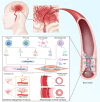Advances in moyamoya disease: pathogenesis, diagnosis, and therapeutic interventions
- PMID: 39822761
- PMCID: PMC11733107
- DOI: 10.1002/mco2.70054
Advances in moyamoya disease: pathogenesis, diagnosis, and therapeutic interventions
Abstract
Moyamoya disease (MMD) is a type of cerebrovascular disease characterized by occlusion of the distal end of the internal carotid artery and the formation of collateral blood vessels. Over the past 20 years, the landscape of research on MMD has significantly transformed. In this review, we provide insights into the pathogenesis, diagnosis, and therapeutic interventions in MMD. The development of high-throughput sequencing technology has expanded our understanding of genetic susceptibility, identifying MMD-related genes beyond RNF213, such as ACTA2, DIAPH1, HLA, and others. The genetic susceptibility of MMD to its pathological mechanism was summarized and discussed. Based on the second-hit theory, the influences of inflammation, immunity, and environmental factors on MMD were also appropriately summarized. Despite these advancements, revascularization surgery remains the primary treatment for MMD largely because of the lack of effective in vivo and in vitro models. In this study, 16 imaging diagnostic methods for MMD were summarized. Regarding therapeutic intervention, the influences of drugs, endovascular procedures, and revascularization surgeries on patients with MMD were discussed. Future research on the central MMD vascular abnormalities and peripheral circulating factors will provide a more comprehensive understanding of the pathogenic mechanisms of MMD.
Keywords: genetic susceptibility; immunity; moyamoya disease; pathogenesis; pathological angiogenesis.
© 2025 The Author(s). MedComm published by Sichuan International Medical Exchange & Promotion Association (SCIMEA) and John Wiley & Sons Australia, Ltd.
Conflict of interest statement
The authors declare no conflicts of interest.
Figures




References
-
- Scott R, Smith ER. Moyamoya disease and moyamoya syndrome. N Engl J Med. 2009;360(12):1226‐1237. - PubMed
-
- Sato Y, Kazumata K, Nakatani E, Houkin K, Kanatani Y. Characteristics of moyamoya disease based on national registry data in Japan. Stroke. 2019;50(8):1973‐1980. - PubMed
-
- Kuriyama S, Kusaka Y, Fujimura M, et al. Prevalence and clinicoepidemiological features of moyamoya disease in Japan. Stroke. 2008;39(1):42‐47. - PubMed
-
- Wakai K, Tamakoshi A, Ikezaki K, et al. Epidemiological features of moyamoya disease in Japan: findings from a nationwide survey. Clin Neurol Neurosurg. 1997;99(2):S1‐S5. - PubMed
-
- Bao X‐Y, Wang Q‐N, Zhang Y, et al. Epidemiology of moyamoya disease in China: single‐center, population‐based study. World Neurosurg. 2019;122:e917‐e923. - PubMed
Publication types
LinkOut - more resources
Full Text Sources
Research Materials
Miscellaneous
